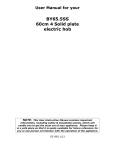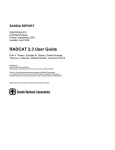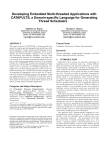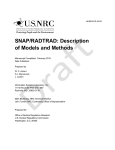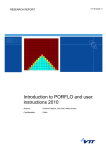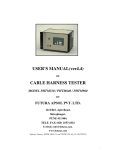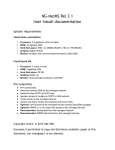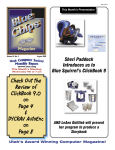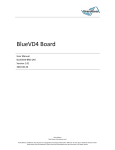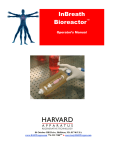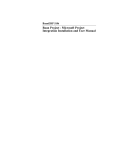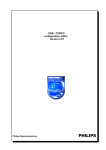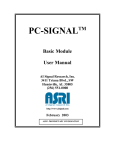Download RADTRAD - the US NRC RAMP Website
Transcript
NUREG/CR-6604 SAND98-0272/1 Supplement 1 RADTRAD: A Simplified Model for RADionuclide Transport and Removal And Dose Estimation Date: June 8, 1999 Prepared by N. E. Bixler C. M. Erickson Sandia National Laboratories P.O. Box 5800 Albuquerque, NM 87185-0739 C.G. Gingrich, NRC Project Manager Prepared for Division of Systems Analysis & Regulatory Effectiveness Office of Nuclear Regulatory Research U.S. Nuclear Regulatory Commission Washington, DC 20555-0001 NRC Job Code Y6062 Abstract This report is a supplement to the original RADTRAD user’s manual. It describes modifications that have been made to the graphical user interface (GUI) and to the numerical engine used to solve coupled ordinary differential equations. Other improvements to the code are also described. A major portion of this report is a replacement to the original user’s guide, which describes how to install and use the current version (3.01). The GUI is now based on Visual Basic and operates quite differently than the GUI used in earlier code versions. The original numerical engine, which was based on the Laplace transform technique, has also been replaced with a new method that is both faster and more accurate. One new test case has been added to the standard test suite. Updated results for the entire suite of test problems are presented. Finally, a description of the new input format is provided. iii NUREG/CR-6604 Contents ACKNOWLEDGMENTS ...................................................................................................................................... VII INTRODUCTION....................................................................................................................................................... 1 1. RADTRAD USER’S GUIDE ............................................................................................................................ 3 1.1 GETTING STARTED........................................................................................................................................... 3 1.1.1 Installation ............................................................................................................................................ 3 1.1.2 Contents of the RADTRAD Installation Folder..................................................................................... 3 1.1.3 Running the RADTRAD Acceptance Cases........................................................................................... 4 1.1.4 Differences in RADTRAD 3.0.1 and Previous Versions........................................................................ 5 1.2 THE GRAPHICAL USER INTERFACE (GUI)........................................................................................................ 6 1.2.1 The Main Form ..................................................................................................................................... 7 1.2.2 The Compartment Form ........................................................................................................................ 8 1.2.3 The Pathway Form.............................................................................................................................. 10 1.2.4 The Dose Location Form .................................................................................................................... 11 1.2.5 The Source Term and Dose Conversion Factors Form....................................................................... 12 1.2.6 The Calculation Control Options Form .............................................................................................. 13 1.2.7 The Text Editor.................................................................................................................................... 14 1.2.8 Data Entry for Compartment Features: Sprays .................................................................................. 15 1.2.9 Data Entry for Compartment Features: Recirculating Filters............................................................ 17 1.2.10 Data Entry for Compartment Features: Natural Deposition .............................................................. 18 1.2.11 Data Entry for Compartment Features: Overlying Pool..................................................................... 23 1.2.12 Data Entry for Transfer Mechanisms: Piping..................................................................................... 25 1.2.13 Data Entry for Transfer Mechanisms: Filter ...................................................................................... 27 1.2.14 Data Entry for Transfer Mechanisms: Air Leakage............................................................................ 28 1.2.15 Data Entry for Transfer Mechanisms: Suppression Pool ................................................................... 29 2. RADTRAD INPUT FILE................................................................................................................................ 30 2.1 2.2 2.3 3. NUMERICAL ALGORITHMS USED IN VERSION 3.01 ......................................................................... 46 3.1 3.2 4. NUMERICAL SOLUTION TECHNIQUE .............................................................................................................. 46 TRANSPORT CALCULATIONS .......................................................................................................................... 47 RADTRAD ACCEPTANCE TEST CASES.................................................................................................. 48 4.1 4.2 4.3 5. SAVING THE INPUT FILE ................................................................................................................................. 30 COMMENTING THE INPUT FILE ....................................................................................................................... 30 INPUT FILE FORMAT ...................................................................................................................................... 31 INTRODUCTION .............................................................................................................................................. 48 SUMMARY OF TEST CASE RESULTS ............................................................................................................... 48 ACCEPTANCE TEST CASE 1A ......................................................................................................................... 53 REFERENCES ................................................................................................................................................ 55 v NUREG/CR-6604 List of Tables TABLE 4.1 PWR--CONTROL ROOM AND NATURAL DEPOSITION TESTS ........................................................................ 49 TABLE 4.2 BWR--CONTROL ROOM AND PIPE DEPOSITION TESTS ................................................................................. 50 TABLE 4.3 PWR--NATURAL DEPOSITION AND SPRAYS TESTS ..................................................................................... 51 TABLE 4.4 PWR AND BWR DECAY AND DAUGHTERING TESTS .................................................................................. 52 TABLE 4.5 ANALYTIC SOLUTION TESTS ....................................................................................................................... 53 NUREG/CR-6604 vi Acknowledgments Most of the modeling capabilities embedded in the RADTRAD code were developed by the original authors of RADTRAD: Steve Humphreys, Terry Heames, LeAnn Miller, and Dave Monroe. Without their efforts, version 3.01 would not be possible. In addition, Dana Powers has made valuable contributions by formulating simplified models to describe aerosol removal mechanisms. The authors also wish to acknowledge those at the NRC who have supported and guided the recent code development, most notably Mark Blumberg and Chester Gingrich. vii NUREG/CR-6604 Introduction The potential radiological consequences of a postulated nuclear power reactor accident depend on the timing, quantity, physical form (i.e., vapor or aerosol), and chemical speciation of the radioactive material released into the environment. The RADionuclide Transport, Removal, And Dose (RADTRAD) code is designed to estimate doses at offsite locations, e.g., the exclusion area boundary (EAB) and low population zone (LPZ), and in the control room of a nuclear power plant. RADTRAD is designed to model two types of releases from the reactor coolant system into the containment. Instantaneous releases are specified in “Calculation of Distance Factors for Power and Test Reactor Sites” (DiNunno et al., 1962) and in Regulatory Guides 1.3 and 1.4 (USNRC, 1974a, 1974b). More protracted and realistic source terms are specified for boiling water reactors (BWRs) and pressurized water reactors (PWRs) in “Accident Source Terms for Light Water Nuclear Power Plants” (Soffer et al., 1995). These instantaneous and protracted releases are represented through input files that are included with RADTRAD. Other source terms can be modeled by modifying one of the standard input files. RADTRAD includes models for a variety of processes that can attenuate and/or transport radionuclides. It can model sprays and natural deposition that reduce the quantity of radionuclides suspended in the containment or other compartments. It can model the flow of radionuclides between compartments within a building, from buildings into the environment, and from the environment into a control room. These flows can be through filters, piping, or simply due to air leakage. The models for flow-through piping can optionally account for aerosol deposition and iodine chemisorption. RADTRAD can also model radioactive decay and in-growth of daughters. The code contains over 25 model and table options. It is anticipated that RADTRAD will be used to estimate the effect of facility modifications and alternative accident management strategies on release of predicted source terms to the environment. These estimates may be used to support probabilistic risk assessment (PRA) and licensing studies. This document is a supplement to the original RADTRAD user’s manual (Humphreys et al., 1998). It describes recent modifications to the code that have resulted in version 3.01. These include a replacement of the graphical user interface (GUI), a replacement of the numerical engine used to solve systems of linear ordinary differential equations (ODEs), and the capability to model multiple source-term compartments. The new computational engine is both faster and more accurate than the original one, which employed the Laplace transform method. This document is organized into four chapters. The first chapter is a user’s guide that describes the process of installing version 3.01 and the new GUI. The second chapter describes the main RADTRAD input file, which contains the plant and scenario information needed to specify an accident sequence. The third chapter briefly describes the new computational engine. Finally, the fourth chapter describes an additional test case that has been added to the standard RADTRAD test suite. It also includes 1 NUREG/CR-6604 updated results for the entire test suite. Some of the results have changed slightly because of the increased accuracy of the new numerical engine. NUREG/CR-6604 2 1. RADTRAD User’s Guide The RADTRAD user’s guide consists of two sections. The first section provides instructions for installing RADTRAD and running the standard test suite. The second section describes the graphical user interface (GUI). This chapter should be useful for both novice and experienced RADTRAD users. 1.1 Getting Started This section covers the installation of the RADTRAD 3.01 code on your computer. The code is supplied on a CD. Installation is automated and should be straightforward. 1.1.1 Installation RADTRAD 3.01 and subsequent versions are intended to run under Windows 95/98 and Windows NT 4.0. Installation requires about 20 MB of disk space and a CD-ROM drive. RADTRAD 3.01 works best with a 17-inch or larger monitor set to a resolution of at least 1024x768 pixels. To install RADTRAD, open the folder corresponding to your CD-ROM drive, then double click on setup.exe. Other applications should be closed. The default installation path is C:\Program Files\Radtrad, but the user can choose any path. RADTRAD may also be installed using Control Panel->Add/Remove Programs. Once installation is complete, the acceptance cases and the default files are available in two forms. The Accept folder contains the acceptance test files with write permission. The Accept/Defaults folder contains nuclide inventory (NIF), release fraction and timing (RFT), and dose conversion factor files (INP) with write permission. The Accept.zip file contains read-only copies of the acceptance cases and defaults files. The Defaults.zip file contains read-only copies of the defaults files, i.e., NIF, RFT, and INP files. RADTRAD can be uninstalled by using Control Panel->Add/Remove Programs. 1.1.2 Contents of the RADTRAD Installation Folder After installing RADTRAD, a main installation folder should have been generated. By default, the main folder will be named \Program Files\Radtrad, but may be given a different name during installation, as described above. The following table describes the structure of the installation folder and each of the files that it contains. Some restrictions on the locations of files are also described in the table. 3 NUREG/CR-6604 Folders Accept Accept/Defaults Accept/SaveAccept Bitmaps Files Accept.zip Defaults.zip Radtrad.dll Radtrad.ini Radtrad301.pdf St5unst.log Vbradtrad.DEP Vbradtrad.exe Acceptance cases (.psf extension). These files are simple concatenations of older .pmf and .sdf acceptance case files, which are retained in the Accept/SaveAccept folder. Three defaults files are needed to run RADTRAD: the nuclide inventory file (.nif extension), the release fraction and timing file (.rft extension), and the dose conversion factors file (.inp extension). These files are in the Defaults folder. The acceptance case input files in the older format, with extensions of .pmf and .sdf Graphical files necessary for vbradtrad.exe. This folder must not be moved or deleted. A zip file that contains the same files that are in the Accept folder, but with read-only permission. The files can be extracted with Winzip or Pkzip. A zip file containing the same files that are in the Defaults folder, but with read-only permission. The files can be extracted with Winzip or Pkzip. The code called to launch a calculation. This file must remain in the same folder as vbradtrad.exe. Text file used to initialize the visual interface to the current RADTRAD version. It must remain in the same folder as vbradtrad.exe. An electronic copy, in Acrobat format, of this document A file required to uninstall RADTRAD using Add/Remove Programs. If it is deleted, uninstall by simply deleting the installation folder. However, doing this will leave the name Radtrad in the Programs menu. To avoid this, reinstall RADTRAD to restore St5unst.log and then remove RADTRAD with Add/Remove Programs. Utility file The starting point of the application. Double click on this filename to run the GUI for developing RADTRAD input (.psf files) and to launch a calculation. 1.1.3 Running the RADTRAD Acceptance Cases To run the acceptance test cases, use the following procedure: 1. Start RADTRAD either from the Programs menu or by double-clicking vbradtrad.exe in C:\Program Files\Radtrad or other installation path. 2. Click Open Radtrad input in the File menu or click the icon on the toolbar. In the resulting dialog form, locate the Accept directory and click Open. Choose an input file from the PSF files displayed (Test1.psf, Test10.psf, etc.). After the file is read and closed, its name and a derived unique filename for RADTRAD output are displayed in the status bars at the bottom of the main RADTRAD form. 3. Recommended: Set full paths for the defaults files as follows: Open the Source Term form by clicking on the button labeled Source Term and DCF... For each of the NUREG/CR-6604 4 required defaults files (Nuclide Inventory, Release Fractions and Timing, and Dose Conversion Factors), click on the appropriate folder tab and then on the Browse button to select the same reference file named in the textbox. This will change the name in the textbox (which was read from the acceptance case test file) to a full path with drive letter. When the user clicks Calculate (step 5), there is a prompt to save input. Changing these paths will only take effect if the file is saved. icon in the 4. To save input, click Save RADTRAD Input in the File menu or click the toolbar. If the file is read-only, the user will have to rename the file to be saved. Existing files with write permission will generate a warning and a choice to replace the existing file or to rename the file about to be saved. It is important to realize that the RADTRAD calculation will use input from the file on disk, not from the data on the forms. 5. Optional: Click the button labeled Control Calc Options to add a title or change the output filename. This button also allows supplemental time steps to be entered, as described in Chapter 2. 6. Click the button labeled Calculate to launch a RADTRAD calculation with the current input file named on the status bar. Save input in 3.01 format if prompted. This also saves the default file paths if they were updated, as recommended in step 3. If the file is not successfully saved in 3.01 format before a calculation is launched, the following error message will be displayed: “Calculation was cancelled, probably due to file format. Save in current format and try again.” The output will be displayed in a simple text editor a few seconds after the calculation is done. 1.1.4 Differences in RADTRAD 3.0.1 and Previous Versions RADTRAD input was formerly contained in two files: the plant model file with extension .pmf and the scenario description file with extension .sdf. These two files are now merged into one RADTRAD input file with a .psf extension. The acceptance cases are in PSF format in the Accept directory; files with the old format are retained in the Accept\SaveAccept folder. A PSF file can be constructed by concatenating a PMF and an SDF file. However, a file created in this fashion must be saved in 3.01 format before a calculation can launched, as explained in the following paragraph. RADTRAD 3.01 allows multiple source term compartments. Any compartment of type Other (i.e., not Control Room or Environment) may be assigned a source term fraction. There is a change in input format to handle this capability. The RADTRAD interface will read either a single source-term format (concatenations of PMF and SDF files) or a multiple source-term format. It will always write files in multiple source-term format. RADTRAD version 3.01 (and future versions) writes a version stamp at the top of the PSF file. This stamp allows RADTRAD to automatically recognize and read multiple formats. Thus, future modifications to the format of PSF files should be transparent to the user. The intention of the RADTRAD developers is to maintain a backward compatibility with previous versions. 5 NUREG/CR-6604 1.2 The Graphical User Interface (GUI) The GUI used in version 3.01 (and subsequent versions) is entirely different than the one used in previous versions (2.xx). The most basic difference is that the GUI in 3.01 uses a Visual Basic interface that runs under Windows 95/98 or Windows NT while the GUI used in versions 2.xx was developed using High Screen Pro and ran under DOS. The user should find the new interface much more flexible and easier to navigate. Basic instructions for using the new GUI are included in the following subsections. 1.2.1 NUREG/CR-6604 6 The Main Form Starting vbradtrad.exe brings up the main form titled RADTRAD 3.01 (or other current version number) shown on the bottom of the preceding page. On it are three combination boxes, one with a dropdown menu of compartment names, the next with a dropdown menu of transfer pathway names, and the third with a dropdown menu of dose locations. If an input file has not been opened, all the names will appear as Unused, as shown here. Selecting any of these names will open the appropriate form for entering plant and scenario data. The combination boxes are arranged in the order in which data are normally entered. The Menu File->Open Radtrad input opens a PSF file and places all data contained in the file on the current forms. This action makes the input data available for modification or for launching a calculation. File->Save Radtrad input saves a PSF file from the data on the current forms. This must be done before launching a RADTRAD calculation in order for any modifications to take effect. This is because the launched calculation reads input data from the file on the disk, not from the data displayed on the forms. File->Read or Print Radtrad output starts a simple text editor. Output files (or other files) can be viewed, edited, and printed from this editor. File->Exit is the formal RADTRAD exit. It releases all memory used by RADTRAD. Another way to exit from RADTRAD is to click the X button at the upper right corner of the control bar. Edit->Clear all input reinitializes all compartment, pathway, dose location, filename, and model data. This same function is automatically performed just before a PSF file is opened. The Toolbar icon is equivalent The toolbar has already been described in Subsection 1.1.3. The to File->Open Radtrad input. The icon is equivalent to File->Save Radtrad input. The icon starts the text editor. The Done Checkboxes Use of these checkboxes is entirely optional. Clicking on a Done checkbox brings up a prompt to save input, but input can also be saved from the menu, the toolbar, or at the prompt just before a RADTRAD calculation is launched. The purpose of these boxes is to help the user keep track of what portions of data entry have been completed. A checked Done box is not preserved when a saved PSF file is reopened–-RADTRAD always starts with these boxes unchecked. 7 NUREG/CR-6604 1.2.2 The Compartment Form Required input data in the Compartments form are Compartment Name other than Unused, Compartment Type, and Volume (unless Type is 3-Environment). Select the Compartment Type from the dropdown list and enter the other items. Any data entered onto the form for a compartment of type 0-Unused will not be saved to a file. The frame labeled Compartment Features is a checklist of possible features (sprays, recirculating filters, natural deposition, or overlying pool). When a feature is checked, the corresponding tabbed folder is brought to the front. The user then selects the appropriate model with the radio buttons, enters its required data, and enters any remaining user-defined coefficients. The appropriate command buttons for each model are enabled when it is chosen. Clicking these command buttons will bring up a data form somewhat like a spreadsheet for data entry. The data forms are described in subsequent subsections. Some of the buttons on the front tabbed folder (here Sprays) are enabled even though Sprays is not checked. The user could enter data under the Sprays tabbed folder, but it would not be saved unless the user checks the Sprays checkbox. The Source Term Fraction entry designates the fraction of the overall source term that should be placed in the current compartment. For example, this value should be 1 if the current volume is to receive the entire source term; it should be 0 for all other NUREG/CR-6604 8 compartments. If the source term is to be split evenly between two compartments, then the Source Term Fraction should be set to 0.5 for those two compartments and to 0 for all others. The Overlying Pool feature becomes available if Compartment Type 3-Other is selected. The Overlying Pool feature is effective only during the ex-vessel phase of severe accidents. The OK and Reset Commands Most forms in the RADTRAD 3.01 interface have a pair of buttons in the upper right corner, OK and Reset. Clicking OK saves the data currently on the form. The word save, as it is used here, does not imply that the data will be saved to a file; only that it will be retained in memory so that if the user later returns to the form, the same data will reappear. (Saving data to a file is discussed in Subsection 1.2.1.) Before data are saved, they are edited (i.e., checked to see if they pass certain requirements, such as being a non-negative number). If they pass the edits, they will be saved for that compartment, pathway, or dose location until modified and saved again or until a new input file is loaded. If there are errors, they will be pointed out to the user during the editing process. Clicking Reset restores the previously saved data. This action bypasses the edit process on the assumption that the previously saved data had already passed the edits. The OK command closes the form, but Reset does not. After clicking Reset, click OK to close the form, or use the Previous or Next commands described below. On the pathway and dose location forms, clicking Reset also updates the dropdown menus of compartment names in case new compartments have been created since the form was first displayed. Be aware, however, that the data on the form that were last saved will also be restored and any unsaved changes will be lost. The Previous and Next Commands Most data entry is controlled from the three forms labeled Compartments, Transfer Pathways, and Dose Locations. These forms have under their titles a horizontal scrollbar and the words Previous and Next at either end, as shown for the Compartments form. Click Previous to go to the previous compartment, pathway, or dose location. The Previous command is ignored when the current entry is the first one. Click Next to go to the next compartment, pathway, or dose location. The Next command is ignored at the maximum values of 10 compartments, 25 pathways, or 10 dose locations. Another way to move among compartments, pathways, and dose locations is to drag the horizontal scrollbar using the left button of the mouse. Any data that have been entered on a form are automatically saved when another compartment is entered. Thus, the user must click Reset before moving to another compartment if he does not wish to save the data that he just entered. As with the OK button, edits are performed on the current data before moving to the next compartment. 9 NUREG/CR-6604 If any errors in the data are found during the edit process, they are highlighted and must be corrected before proceeding. 1.2.3 The Pathway Form Required inputs for each active pathway are From Compartment, To Compartment, Pathway Name, and Transfer Mechanism. Pathways that do not have Yes selected under Active Pathway will not be saved to a file. Active Pathway is set to Yes by default when a Transfer Mechanism is selected. Only one Transfer Mechanism can be selected for a transfer pathway. When the user indicates a transfer mechanism, the corresponding tabbed folder is brought to the front, where user-defined coefficients are entered or a model is chosen and its requirements are entered. Requirements for Transfer Mechanism data are described later in this chapter. NUREG/CR-6604 10 1.2.4 The Dose Location Form Required dose-location inputs are Name other than Unused, In Compartment, χ/Q, and Breathing Rate (BR). A control room compartment also requires Occupancy Factors to be specified. The user may select appropriate defaults in BR Defaults by clicking on EAB or LPZ or Control Room. Dose Locations with Unused as part of their name (case insensitive) will not be saved to a file. Tables with a time value in hours followed by one or more values are used throughout the RADTRAD interface. The rules for these tables are consistent. The first time value is always 0.0000 and cannot be modified. Tabulated values are treated as piecewise constants. Thus, the value to the right of 0.0000 is in effect until the second value of time is reached. At that time, the value to the right of this time takes effect. There is no interpolation of the tabular values. If only one value is entered at time zero, it remains in effect throughout the calculation. If the second time in the table is the final time of the calculation, often 720 hours, then the value to the right of this time is inconsequential. 11 NUREG/CR-6604 1.2.5 The Source Term and Dose Conversion Factors Form Required inputs on this form are NIF File (nuclide inventory file), RFT File (release fraction and timing file), and DCF File (dose conversion factor file), Decay and Daughter Products option, and Iodine Chemical Fractions. Plant Power must also be set in order to perform a nontrivial calculation. Clicking the Default PWR, Default BWR, or Default TID buttons will place an entry into the NIF File box. The default file names will work correctly when a Defaults folder is in the same directory as the input PSF file. If it is not, the user should select the User Inventory option and then use the browse function to locate the appropriate file. The process is similar for each of the tabbed folders, i.e., Release Fraction and Timing and Dose Conversion Factors. While not necessary, it is recommended that the user verify the full path of the NIF, RFT, and INP files by using the Browse button to locate each of these files. Doing so will cause a full, valid path, beginning with a drive letter, to be appear. If an invalid path NUREG/CR-6604 12 is saved to the PSF file, then a launched RADTRAD calculation will abruptly terminate (with no error message) because it cannot find the specified file. Clicking either TID or 1465 selects the appropriate iodine chemical fractions documented in the original RADTRAD manual. The user may modify the iodine chemical fractions manually, but they must always sum to unity. 1.2.6 The Calculation Control Options Form There is no required input for this form. The optional Case Title allows the user to insert a short description of the calculation in the input file (PSF file) that is written. This description is also echoed to the output file generated when a RADTRAD calculation is launched. A unique Output File name is chosen as the default when an input file is opened, but it can be modified on this form. The default nomenclature for the output file name is to use an extension of .Ox, where x is the smallest nonnegative integer that does not lead to a conflict with an existing file. 13 NUREG/CR-6604 The Show Results options allow the user to customize the level of RADTRAD output. Five options can be selected, each adding a level of detail to the output file. If nonzero Supplemental Time Steps are entered, the time steps will be no larger than the specified value until the next value of time is reached. Ordinarily, the internal time-step controls in RADTRAD are adequate to obtain a high level of accuracy so supplemental time steps need not be specified. However, this option is available so that the user can check the sensitivity of results to time-step size. 1.2.7 The Text Editor The editor that pops up automatically at the end of a RADTRAD calculation is shown here for one of the acceptance test cases (Test10.psf). The end of the file can be reached by pressing Control-End. The vertical scroll bar can also be used to move up or down within the displayed file. Sections may be cut from the file and the shortened file saved, or selected blocks of text may be copied to the system clipboard for use with other applications. From the NUREG/CR-6604 14 Edit menu, the user may comma- or tab-separate a selected block of text. This is convenient for pasting into a spreadsheet from the system clipboard. The user can also undo the tab and comma operations. From the text editor, any ASCII text file can be located and edited by using the drive, folder, and file windows at the right of the text. The text editor can be opened at any time during a RADTRAD session. To open it, click the button labeled Read Output or Print or click the icon on the toolbar. 1.2.8 Data Entry for Compartment Features: Sprays Removal Coefficients Acceptance case Test23 is illustrated here. The tabular values are removal coefficients for aerosol, elemental iodine, and organic iodine in units of fraction per hour. Edits: Time values must be entered in ascending order. Removal coefficients must be non-negative numbers. 15 NUREG/CR-6604 Access: On the Compartments form, check the Sprays feature to bring forward the sprays tabbed folder. Then click the enabled User-Defined Coefficients button to pop up this form. Powers Aerosol Model Acceptance case Test24a is illustrated here. This form contains spray flux in cubic feet per minute per square foot and height of the spray in meters. Other required parameters are the fraction of the volume that is sprayed and the percentile. Selecting 10% gives a reasonable lower-bound estimate for aerosol removal, 50% gives a mean value, and 90% gives a reasonable upper bound. Edits: Time values must be entered in ascending order. Flux, height, and fraction sprayed must be non-negative. NUREG/CR-6604 16 Access: On the Compartments form, check the Sprays feature to bring forward the sprays tabbed folder. Choose the Powers option. Click the enabled Powers Aerosol Model button to pop up this form. Removal coefficients for elemental and organic iodine can also be entered in the same way as illustrated above for the User-Defined Coefficients option. 1.2.9 Data Entry for Compartment Features: Recirculating Filters Filter Efficiencies Acceptance case Test10 is illustrated here. The data on this form specify filter efficiencies in units of percent for aerosols, elemental iodine, and organic iodine. Edits: Time values must be entered in ascending order. Filter efficiencies must be nonnegative and no larger than 100%. 17 NUREG/CR-6604 Access: On the Compartments form, check the Recirculating Filters feature. On the Recirculating Filters tabbed folder, click the enabled Edit Efficiencies button to pop up this form. 1.2.10 Data Entry for Compartment Features: Natural Deposition User-Defined Coefficients Acceptance case Test23 is illustrated here. Values are removal coefficients in units of fraction per hour. Edits: Time values must be entered in ascending order. Removal coefficients must be non-negative. Access: On the Compartments form, check the Natural Deposition feature. Choose the User-Defined Coefficients option. Click the enabled User-Defined Coefficients button to pop up this form. NUREG/CR-6604 18 Henry Aerosol Model Acceptance case Test5 is illustrated here. Input values are the spray fall height (i.e., the vertical distance between the spray nozzles and the floor of the containment) in meters and the aerosol particle density in grams per cubic centimeter. Edits: Time values must be entered in ascending order. Fall height and particle density must be non-negative. Access: On the Compartments form, check the Natural Deposition feature. Choose Henry on the Natural Deposition tabbed folder. Click the enabled Henry Aerosol Model button to pop up this form. 19 NUREG/CR-6604 Elemental Iodine Removal Coefficients Acceptance case Test5 is illustrated here. Values are removal rate for elemental iodine in units of fraction per hour. Edits: Time values must be entered in ascending order. Removal Coefficients must be non-negative. Access: On the Compartments form, check the Natural Deposition feature. On the Natural Deposition tabbed folder, choose the Henry Aerosol Model option. Click the enabled Elemental Iodine button to pop up this form. NUREG/CR-6604 20 Powers Aerosol Model Acceptance case Test10 is illustrated here. The values reflect the percentile in terms of probability. Selecting 10% gives a reasonable lower-bound estimate for aerosol removal, 50% gives a mean value, and 90% gives a reasonable upper-bound estimate. A reactor and accident type must also be selected. Note that this model was developed to model aerosol deposition in containment volumes where the surface-to-volume ratio is relatively small. Applying this model to other types of compartments, i.e., where surface-to-volume or aspect ratios are substantially different than those of a containment, is likely to lead to significant errors. Edits: None. Access: On the Compartments form, check the Natural Deposition feature to bring forward the Natural Deposition tabbed folder. Choose the Powers Containment option. Click the enabled Powers Aerosol Model button to pop up this form. 21 NUREG/CR-6604 Data Entry for Compartment Features: Overlying Pool User-Defined Decontamination Factors No acceptance cases use the overlying pool feature. Values are decontamination factors, which are dimensionless. Edits: Time values must be entered in ascending order. Decontamination factors must be 1 or greater. Access: On the Compartments form, check the Overlying Pool feature. On the Overlying Pool tabbed folder, choose the User-Defined Coefficients option. Click the enabled User-Defined Coefficients button to pop up this form. 23 NUREG/CR-6604 Powers Aerosol Model No acceptance cases use the overlying pool feature. Input values are percentile in terms of probability, pool depth in feet, and pool temperature in degrees Fahrenheit. Selecting 10% gives a reasonable lower-bound estimate for aerosol removal, 50% gives a mean value, and 90% gives a reasonable upper-bound estimate. Edits: Time values must be entered in ascending order. Pool Depth must be nonnegative. Pool temperatures must be at least 36°F. Recommended ranges are pool depths of 1 to 6 feet and pool temperatures of 86 to 212°F. Access: On the Compartments form, check the Overlying Pool feature. On the Overlying Pool tabbed folder, choose the Powers option. Click on the enabled Powers Aerosol Model button to pop up this form. The form for entering Elemental and Organic Iodine decontamination factors is analogous to the one for User-Defined Decontamination Factors, except that the aerosol column is omitted. NUREG/CR-6604 24 1.2.12 Data Entry for Transfer Mechanisms: Piping User-Specified Removal Coefficients Acceptance case Test23 is illustrated here. Input values are removal coefficients in units of fraction per hour. Edits: Time values must be entered in ascending order. Removal coefficients must be nonnegative. Access: On the Pathways form, choose the Piping transfer mechanism. On the Piping tabbed folder, choose User-Specified Coefficients. Then click Edit Removal Coefficients to pop up this form. 25 NUREG/CR-6604 Brockmann-Bixler Model Acceptance case Test14b is illustrated here. Input values are flow rates in cubic feet per minute, gas pressure in the atmosphere, and gas temperature in degrees Fahrenheit. Edits: Time values must be entered in ascending order. Flow rate, gas pressure, volume, inner surface area, and total pipe bend angle must be non-negative. Gas temperatures must be at least 32 °F. Access: On the Pathways form, choose the Piping mechanism. On the Piping tabbed folder, choose Brockmann-Bixler. Click Edit Removal Coefficients to pop up this form. NUREG/CR-6604 26 1.2.13 Data Entry for Transfer Mechanisms: Filter Filter Efficiencies Acceptance case Test24a is illustrated here. Input values are flow rates in cubic feet per minute and filter efficiencies in percent. Edits: Time values must be entered in ascending order. Efficiencies must be nonnegative and no greater than 100. Access: On the Pathways form, choose the Filter mechanism. On the Filter tabbed folder, click Edit Efficiencies to pop up this form. 1.2.14 27 NUREG/CR-6604 Data Entry for Transfer Mechanisms: Air Leakage Air Leakage Rates Acceptance case Test21 is illustrated here. Input values are leakage rates in units of percent of volume (from which air leaks) per day. Edits: Time values must be entered in ascending order. Leakage rates must be nonnegative. Access: On the Pathways form, choose the Air Leakage mechanism. Leakage tabbed folder, click Edit Rates to pop up this form. 1.2.15 NUREG/CR-6604 28 On the Air Data Entry for Transfer Mechanisms: Suppression Pool Edit Selected Models There are no acceptance cases that use this model. Input values are flow rate in cubic feet per minute and decontamination factors, which are dimensionless. Edits: Time values must be entered in ascending order. Decontamination Factors must be greater than or equal to 1. Access: On the Pathways form, choose the Suppression Pool mechanism. On the Suppression Pool tabbed folder, check the models for which you want to enter data. Click Edit Selected Models to pop up this form. In this case the user selected all three models, i.e., Aerosol, Elemental I, and Organic I. 29 NUREG/CR-6604 2. RADTRAD Input File 2.1 Saving the Input File After the input to the main form has been entered via the Compartment, Pathway, Dose Location, and Source Term forms, the user should save a RADTRAD input file. There are several ways to perform the save. Each of the actions in this table saves input or leads to saving input. From the File menu, select Save Radtrad input Click the diskette icon on the toolbar Check any Done checkbox to be prompted to save input Right-click in the main form margin and select the Save inputs menu item Click the Compute button to be prompted to save input Click File->Exit to exit the program to be prompted to save input Saving input is a critical step. When the user clicks Calculate to run RADTRAD, the data that are visible on the forms are not used. Instead, the RADTRAD calculation reads the contents of the filename shown on the main-form upper status bar near the bottom of the frame. The lower status bar shows the name of the file to which RADTRAD output will be written. The RADTRAD input file name is filename.psf. Long filenames may be used. The maximum length of any filename in RADTRAD, including drive letter:\path\filename, is 256 characters. Use of a remote file on a mapped network drive should work as long as the full path is specified. This applies to input, output, or reference files such as nuclide inventory and dose conversion files. 2.2 Commenting the Input File Comments may be added on lines designated “plain text” or after numerically formatted data items. Adding comments on lines that contain filenames will cause RADTRAD to crash. The text editor accessed from the Read Output and Print button or File menu item can be used to put comments on existing lines of an input file. Other text editors, such as Notepad or Wordpad, can also be used. There is no provision for adding more comment lines to the file than can be accommodated by these inline methods. Adding additional lines to the input file will cause RADTRAD to crash. NUREG/CR-6604 30 2.3 Input File Format In the table of variables below, the second column lists an abbreviation of the relevant form name for each user-specified variable. The key to the abbreviations follows here. Key to Form Column CO Compartments form TP Transfer Pathways form DL Dose Locations form ST Source Term form CL Calculation Control Options form If a form abbreviation is not noted next to a variable name or heading, the user is not responsible for the input. For CO and TP tabular input, the popup data forms shown above are created as needed. DL, ST, and CL forms do not use popup forms. The Plant Model Section of the RADTRAD Input File Plain text or variable name Form Format Comments Plant Model Name: plant_model_name 1x, a19 CL Nuclide Inventory File: inventory_filename printable ASCII characters 1x, a21 ST Plant Power Level: plant_power_level a40 a256 file name extension must be .nif; use of full path is recommended 1x, a20 ST f11.4 Compartments: 1x, a25 number_of_compartments i2 units = megawatts thermal valid range > 0.0 valid range = 0 to 10 inclusive The following input format is used for each compartment. Compartment N: 1x, a12, i3,a1 This line is not used. compartment_name(N) CO a40 printable ASCII characters compartment_type(N) CO 1x,i1 1 = control room, 2 = environment, 3 = other 31 NUREG/CR-6604 compartment_volume(N)CO 1x, e12.4 units = meter3 valid range > 0.0 compartment_sprays(N)CO 1x, i1 0 = no sprays 1 = sprays present compartment_sump(N) 1x, i1 0 = sump not present compartment_filters(N) CO 1x, i1 0 = no recirculating filters 1 = recirculating filters present compartment_deposition(N) CO 1x, i1 0 = no natural deposition 1 = natural deposition compartment_opool(n) CO 1X,i1 0 = no overlying pool 1 = overlying pool Repeat the above section of input for each compartment used. Pathways: 1x, a9 number_of_pathways i2 valid range = 0 to 25 inclusive. The following input format is used for each compartment-to-compartment pathway. Pathway N: 1x, a9,i2,a4 pathway_name(N) TP a40 printable ASCII characters pathway_from(N) TP i2 valid range = 1 to number_of_compartments inclusive pathway_to(N) TP i2 valid range = 1 to number_of_compartments inclusive pathway_type(N) TP i1 1 = piping 2 = filtered pathway 3 = suppression pool 4 = air leakage Repeat the above section of input for each pathway used. NUREG/CR-6604 32 The Scenario Description Section of the RADTRAD Input File Formerly this section was a second input file. It is now concatenated with the plant file with no changes to the line format except for the version 3.01 multiple-source input. Plain text or variable name Form Scenario Description Name: scenario_name Format Comments 1x, a26 CL 1x, a40 Plant Model File Name: 1x, a21 plant_filename 1x, a40 Source Term: 1x, a12 Number_of_sources 1x, i3 printable ASCII characters not used; carriage return needed Number of data lines to follow. M = count. Compartment_number CO (1x,i3, sourceterm_fraction (1-M) CO 1x,e12.4) These two are on one line, with M lines. dose_conversion_filename ST 1x, a256 Filename extension must be INP. Use of full path is recommended. release_filename ST 1x, a256 Filename extension must be RFT. Use of full path is recommended. delay_time ST 1x, e12.4 valid range = > 0.0 hours calculate_daughters ST 1x, i3 0 = no daughters are calculated 1 = all daughters are calculated i_fraction_aerosol i_fraction_elemental i_fraction_organic ST ST ST 4(1x,e12.4) valid range = 0.0 to 1.0 valid range = 0.0 to 1.0 valid range = 0.0 to 1.0 These three variables must total 1.0 valid range = 0.0 to 1.0 These four variables are on one line. i_fraction_radioactive Overlying Pool: 1x, a15 op_decay ST 1x, i3 0 = no decay chain processing 1 = decay chain processing op_initial_volume CO 1x, e12.4 units = cubic meters valid range > = 0.0 op_aerosol_model CO 1x, i3 0 = no aerosol removal 1 = user-specified decontamination factors 2 = decontamination factors calculated using the Powers model 33 NUREG/CR-6604 Overlying Pool: Aerosol: User-defined decontamination factors The next two lines are included only if the user-specified decontamination factors are used (op_aerosol_model = 1). op_aerosol_count op_aerosol_time(1-M) op_aerosol_df(1-M) CO CO 1x, i3 valid range = 1 to 10 inclusive. M = count. 2(1x, e12.4) units = hours valid range = 0.0 to 1.0 These two are on one line, with M lines. End of user-specified decontamination factors. Overlying Pool: Aerosol: Powers model The next three lines are included only if the Powers model for calculating the decontamination factors is used (op_aerosol_model = 2.). op_aerosol_percentile CO op_aerosol_count op_aerosol_time(1-M) op_aerosol_height(1-M) op_aerosol_cooling(1-M) CO CO CO 1x, e12.4 10.0 = 10th percentile model 50.0 = 50th percentile model 90.0 = 90th percentile model 1x, i3 valid range = 1 to 10 inclusive. M = count. 3(1x, e12.4) units = hours units = meters units = K These three are on one line, with M lines. End of Powers model-calculated decontamination factors. Overlying Pool: Elemental Iodine: User-defined decontamination factors op_elemental_model CO 1x, i3 0 = no elemental iodine removal 1 = user-specified decontamination factors These lines are included only if user-specified decontamination factors are used (op_elemental_model = 1). op_elemental_count op_elemental_time(1-M) op_elemental_df(1-M) 1x, i3 CO CO 2(1x, e12.4) End of user-specified decontamination factors. NUREG/CR-6604 34 1-10 = number of decontamination factors. M = count. units = hours valid range = 0.0 to 1.0 These two are on one line, with M lines. Overlying Pool: Organic Iodine: User-defined decontamination factors op_organic_model CO 1x, i3 0 = no organic iodine removal 1 = user-specified decontamination factors These lines are included only if user-specified decontamination factors are used (op_organic_model = 1). op_organic_count op_organic_time(1-M) op_organic_df(1-M) 1x, i3 CO CO 2(1x, e12.4) 1-10 = number of decontamination factors M=count. units = hours valid range = 0.0 to 1.0 These two are on one line, with M lines. End of user-specified decontamination factors. op_volatilization_model 1x, i3 0 = no iodine volatilization. Not used. Placeholder zero is always present. Compartments: 1x, a13 number_of_compartments 1x, i3 The number of compartments specified in the plant section of the file. Compartment n: 1x, a12,i3,a1 This line is not used. compartment_detail(N) CO 1x, i3 0 = no detail output printed 1 = detail output printed compartment_decay(N) ST 1x, i3 0 = no decay chain processing 1 = decay chain processing CO 1x, i3 0 = no aerosol removal 1 = user-specified aerosol removal coefficients 2 = aerosol removal coefficients calculated using the Powers model Compartments: Sprays format sprays_aerosol_model(N) Sprays: Aerosol: User-defined removal coefficients The next three lines are included if the user-specified removal coefficients are used (sprays_aerosol_model(N) = 1). Fresh_water_fraction e12.4 Not used. Placeholder required. sprays_aerosol_count(N) 1x, i3 1-10 = number of aerosol removal coefficients. 35 NUREG/CR-6604 M = this count. N = this compartment number. sprays_aerosol_time(N)(1-M) CO sprays_aerosol(N)(1-M) CO units = hours 2(1x, e12.4) units = per second These two are on one line with M lines. Sprays: Aerosol: Powers model The next five lines are included if the Powers model is used (sprays_aerosol_model(N) = 2.). Fresh_water_fraction 1x,e12.4 Not used. Placeholder required. Sprays_aerosol_alpha CO 1x,e12.4 Fraction sprayed. sprays_aerosol_percentile(N) CO 1x, e12.4 10.0 = 10th percentile model 50.0 = 50th percentile model 90.0 = 90th percentile model 1x, i3 1-10 = number of times for which flux and height provided . sprays_aerosol_count(N) M = this count. N = this compartment number. sprays_aerosol_time(N)(1-M) sprays_aerosol_flux(N)(1-M) CO CO sprays_aerosol_height(N)(1-M) CO 3(1x, e12.4) units = hours units = cubic meters of water per square meter per second units = meters These three are on one line with M lines. End of Powers sprays model. Sprays: Elemental Iodine: Removal coefficients sprays_elemental_model(N) 1x, i3 0 = no elemental iodine removal; 1 = elemental iodine removal The next three lines are present only if elemental I removal coefficients are used (sprays_elemental_model(N) = 1). Fresh_water_fraction 1x,e12.4 sprays_elemental_count(N) Not used. Placeholder required 1x, i3 1-10 = number of removal coefficients. M = this count. N = this compartment number. sprays_elemental_time(N)(1-M) NUREG/CR-6604 CO units = hours 36 sprays_elemental(N)(1-M) CO 2(1x, e12.4) valid range = 0.0 to 1.0 These two are on one line for M lines. End of elemental iodine removal coefficients. Sprays: Organic Iodine: Removal coefficients sprays_organic_model(N) CO 1x, i3 0 = no organic iodine removal; 1 = organic iodine removal The next three lines are present only if organic iodine removal coefficients are used (sprays_organic_model(N)=1). Fresh_water_fraction 1x,e12.4 Not used. Placeholder required sprays_organic_count(N) 1x, i3 1-10 = number of removal coefficients. M = this count. N = this compartment number. sprays_organic_time(N)(1-M) sprays_organic(N)(1-M) CO CO 2(1x, e12.4) units = hours valid range = 0.0 to 1.0 These two are on one line, with M lines. End of organic iodine removal coefficients. sump_volatilization_count(N) 1x, i3 0 = no iodine volatilization. Not used. Placeholder required. Compartments: Recirculating filter format C_filter_eff_model(N) CO 1x, i3 0 = no filter action . 1 = filter action The next three lines are included only if the recirculating filter feature is used (C_filter_eff_model (N) = 1). c_filter_norm_flow_rate(N) CO c_filter_eff_count(N) 1x, e12.4 units = per second 1x, i3 1-10 = number of filter efficiencies. M = this count. N = this compartment number. c_filter_aerosol_eff(N)(1-M) CO c_filter_elemental_eff(N)(1-M) CO units = percent valid range = 0.0 to 100.0 inclusive units = percent valid range = 0.0 to 100.0 inclusive 37 NUREG/CR-6604 c_filter_organic_eff(N)(1-M) CO 3(1x, e12.4) units = percent valid range = 0.0 to 100.0 inclusive. These three are on one line, with M lines. Compartments: Natural deposition format deposit_aerosol_model(N) CO 1x, i3 0 = model is not used 1 = user-specified aerosol removal coefficients 2 = aerosol removal coefficients calculated using the Henry model 3 = coefficients calculated using the Powers deposition model. Natural Deposition: Aerosol: User-specified decontamination factors. The next two lines are included if the user-specified decontamination factors are used (deposit_aerosol_model(N) = 1). deposit_aerosol_count(N) CO 1x, i3 1-10 = number of aerosol removal coefficients supplied or calculated M = this count. N = this compartment number. deposit_aerosol_time(N)(1-M) deposit_aerosol(N)(1-M) CO CO units = hours units = per second These two are on one line for M lines. 2(1x, e12.4) End of user-specified aerosol decontamination factors. Natural Deposition: Aerosol: Henry model The next two lines is present (deposit_aerosol_model(N) = 2). deposit_aerosol_count(N) only if CO the Henry model is used 1x, i3 1-10 = number of time for which height, partial density provided. M = this count. N = this compartment number deposit_aerosol_time(N)(1-M) deposit_height(N)(1-M) CO CO deposit_part_density(N)(1-M) CO NUREG/CR-6604 3(1x, e12.4) units = hours units = meters units = grams/cc These three are on one line for M lines. 38 End of the Henry deposition model. Natural Deposition: Aerosol: Powers model The next two lines is present only if the Powers deposition model is used (deposit_aerosol _model(N) = 3). deposit_aerosol_reactor CO deposit_aerosol_percentile 1x,i3 CO 1=PWR-DBA; 2=PWR-SA; 3=BWR-DBA; 4=BWR-SA 5=APWR-DBA 1x, e12.4 10.0 = 10th percentile model 50.0 = 50th percentile model 90.0 = 90th percentile model. End of Powers deposition model. Natural Deposition: Elemental I: Removal coefficients deposit_elemental_model(N) CO 1x, i3 0 = no elemental iodine removal. 1 = elemental iodine removal The next two lines are present only if there is elemental iodine removal (deposit_elemental_model(N) = 1). deposit_elemental_count(N) CO 1x, i3 1-10 = number of elemental iodine removal coefficients. M = this count. N = this compartment number deposit_elemental_time(N)(1-M) deposit_elemental(N)(1-M) CO CO units = hours 2(1x, e12.4) units = per second These two are on one line for M lines. Pathways: 1x, a9 number_of_pathways 1x, i3 Pathway n: 1x, a10,1x,i2 pathway_detail(N) 1x, i3 Not used. Placeholder required. pathway_decay(N) 1x, i3 Not used. Placeholder required. 1x, i3 valid range = 0 to 1 inclusive 0 = no aerosol removal valid range = the number of pathways specified in the plant section of the file N=this pathway number Piping Format piping_aerosol_model(N) TP 39 NUREG/CR-6604 1 = user-specified decontamination factors 2 = Brockmann-Bixler model. Piping: User-defined decontamination factors The next two lines are included only if the user-specified decontamination factors are used (piping_aerosol_model = 1). piping_aerosol_count(N) 1x, i3 valid range = 1 to 10 inclusive M= this count. N= this pathway. piping_aerosol_time(N)(1-M) piping_aerosol_df(N)(1-M) piping_aerosol_flow(N)(1-M) TP TP TP 3(1x, e12.4) units = hours its = per second units = cubic meters per second These three are on one line for M lines. End of user-defined decontamination factors. Piping: Brockmann-Bixler model The next five lines are included only if the Brockmann-Bixler model is used (piping_aerosol_ model = 2). piping_aerosol_count(N) 1x, i3 Valid range = 1-10 times for which model data is provided. M= this count. N= this pathway. Brock_surface(N) Brock_volume(N) Brock_angle(N) brock_time(N)(1-M) brock_flow(N)(1-M) brock_pressure(N)(1-M) TP TP TP TP TP TP brock_temp(N)(1-M) TP 1x, e12.4 1x, e12.4 1x, e12.4 4(1x, e12.4) units = sq ft units = cu ft units = degrees units = hours units = cubic meters per second units = atmospheres units = degrees F. These four are on one line for M lines. End of Brockmann-Bixler model. Piping: Elemental I: User-defined decontamination factors piping_elemental_model(1) TP 1x, i3 0 = no elemental iodine removal 1 = user-specified elemental iodine decontamination factors The next two lines are included only if the user-specified decontamination factors are used (piping_elemental_model = 1). piping_elemental_count(N) TP 1x, i3 valid range = 1 to 10 inclusive M= this count. N = this pathway. NUREG/CR-6604 40 piping_elemental_time(N)(1-M) piping_elemental_df(N)(1-M) piping_elemental_flow(N)(1-M) TP TP TP 3(1x, e12.4) units = hours units = per second units = cubic meters per second These three are on one line for M lines. End of Elemental I user-specified decontamination factors. Piping: Organic I: User-defined decontamination factors piping_organic_model(N) TP 1x, i3 0 = no aerosol removal 1 = user-specified aerosol decontamination factors These lines will be included if and only if the user-specified decontamination factors are used (piping_organic_model = 1). piping_organic_count(N) piping_organic_time(N)(1-M) piping_organic_df(N)(1-M) piping_organic_flow(N)(1-M) 1x, i3 valid range = 1 to 25 inclusive TP TP TP 3(1x, e12.4) units = hours units = per second units = cubic meters per second These three are on one line for M lines. TP 1x, i3 0 = no filter action. 1= filter action. Filter format p_filter_eff_model(N) The next three lines are included only if p_filter_eff_model(N) = 1. p_filter_eff_count(N) 1x, i3 valid range = 1 to 10 inclusive 1-10 = number of filter efficiencies. M = this count. N = this pathway. p_filter_norm_time(N)(1-M) TP 5(1x, e12.4) units = hours p_filter_norm_flow_rate(N) TP units = per second p_filter_aerosol_eff(N)(1-M) TP for all efficiencies units = percent and valid range = 0.0 to 100.0 p_filter_elemental_eff(N)(1-M) p_filter_organic_eff(N)(1-M) TP TP These five variables are on one line for M lines. Suppression pool format: Aerosol: Decontamination factors sp_aerosol_model(N) TP 1x, i3 0 = no aerosol removal 1 = user-specified decontamination factors The next three lines are included only if the user-specified decontamination factors are used (sp_aerosol_model(N) = 1). 41 NUREG/CR-6604 sp_initial_volume(N) TP sp_aerosol_count(N) sp_aerosol_time(N)(1-M) TP sp_aerosol_df(N)(1-M) TP 1x, e12.4 units = cubic meters valid range > 0.0 0.0 = no suppression pool 1x, i3 valid range = 1 to 10 units = hours 2(1x, e12.4) valid range = 0.0 to 1.0 These two variables are on one line for M lines. Suppression pool format: Elemental I: Decontamination factors sp_elemental_model(N) TP 1x, i3 0 = no elemental iodine removal 1 = user-specified decontamination factors The next two lines are present only if user-specified decontamination factors are used (sp_elemental_model(N) = 1). sp_elemental_count(N) sp_elemental_time(N)(1-M) sp_elemental_df(N)(1-M) 1x, i3 TP TP 2(1x, e12.4) valid range = 1 to 10. M = this count. N = this pathway. units = hours valid range = 0.0 to 1.0 These two variables are on one line for M lines. Suppression pool format: Organic I: Decontamination factors sp_organic_model(N) TP 1x, i3 0 = no organic iodine removal 1 = user-specified decontamination factors The next two lines are included only if user-specified decontamination factors are used (sp_organic_model(N) = 1). sp_organic_count(N) 1x, i3 1-10 = number of decontamination factors. M = this count. N = this pathway. sp_organic_time(N)(1-M) sp_organic_df(N)(1-M) TP TP 2(1x, e12.4) sp_volatilization_model(N ) 1x, i3 NUREG/CR-6604 42 units = hours valid range = 0.0 to 1.0 These two variables are on one line for M lines. 0 = no iodine volatilization. Not used. Placeholder value required. Air leakage format convection_model(N) TP 1x, i3 0 = no natural convection 1 = user-specified normalized flow rates The next two lines are included only if the user-specified decontamination factors are used (convection_model(N) = 1). convection_count(N) 1x, i3 M = this count. N = this pathway. Valid range = 1 to 10 . 1x, e12.4 units = per second water_leakage_model(1) 1x, i3 0 = no water leakage. Not used. Placeholder value is required. Dose Locations: 1x, a15 number_of_locations 1x, i3 Location L: 1x, a11 convection_norm_flow(N)(1-M) TP valid range = 0 to 10 location_name(L) DL 1x, a40 valid range = printable ASCII char(32) to char(126) inclusive compartment_number(L) DL 1x, i3 valid range = 1 to n inclusive the number of the compartment that the location is in. 1x, i3 0 = Χ/Q is a constant 1.0 1 = user-specified Χ/Q. Valid only for compartments other than control room. Chi/Q format location_xq_model(L) The next two lines are included only if location_xq_model(L) = 1. location_xq_count(L) 1x, i3 Number of times for which input is provided. Valid range = 1-10. M = count. Location_xq_time(L)(1-M) DL (1x, i3 units = hours Location_xq(L)(1-M) DL 1x, e12.4) units = seconds/ cu m. These two variable are on one line for M lines. DL 1x,i3 0 = no breathing rate input Breathing rate format Location_breathing_rate_model 1 = breathing rate input The next two lines are included only if location_breathing_rate_model(L) = 1. 43 NUREG/CR-6604 location_br_count(L) 1x, i3 Number of times for which input is provided. Valid range = 1-10. M = count. Location_br_time(L)(1-M)DL (1x, i3 units = hours Location_breathing_rate(L)(1-M) DL 1x, e12.4) units = cu m /second. These two variable are on one line for M lines. DL 1x,i3 0 = no occupancy factor input Occupancy factor format Location_occupancy_model 1 = occupancy factor input . Valid only for control-room compartment type 1. The next two lines are included only if location_occupancy_model(L) = 1. location_occupancy_count(L) 1x, i3 Number of times for which input is provided. Valid range = 1-10. M = count. Location_occupy_time(L)(1-M) DL (1x, i3 units = hours Location_occupy_factor(L)(1-M) DL 1x, e12.4) unitless. These two variables are on one line for M lines. Repeat from “Location L:” for all dose locations. Effective Volume Location: Eff_vol_xq_model 1x, a26 DL 1x,i3 0 = no effective volume input 1 = effective volume input . Controlroom X/Q is input here. The next two lines are included only if eff_vol_xq_model =1. Eff_vol_xq _count(L) 1x, i3 Number of times for which input is provided. Valid range = 1-10. M = count. units = hours Eff_vol_xq _time(L)(1-M) DL (1x, i3, Eff_vol_xq (L)(1-M) DL 1x, e12.4) unitless. These two variables are on one line for M lines. 1x, a22 Plain text line is not used. Simulation Parameters: Dt_max_count 1x,i3 Number of times for which supplemental time steps are provided. Valid range = 0 to 10. M = count. The next line is present only if M is greater than zero. Dt_max_time(1-M) NUREG/CR-6604 CL 2(1x, e12.4) 44 Units = hours. Dt_max Output Filename: 1x,a16 CL Units = hours. Maximum time step. These two are on one line for M lines. Plain text line is not used. Output_filename CL 1x,a256 Name of output file. Use of full path is recommended. Show_plant CL 1x,i3 Include plant model. Show_scenario CL 1x,i3 Include scenario description. Show_event CL 1x,i3 Show results for every simulation event. Show_step CL 1x,i3 Show results for every supplemental time step. Show_model CL 1x,i3 Include runtime model information. End of Scenario File 1x, a32 45 NUREG/CR-6604 3. Numerical Algorithms Used in Version 3.01 This section addresses the mathematical solution method used to ultimately calculate the doses at various locations. The overall numerical solution technique is discussed in Section 3.1. The numerical engine used to solve coupled sets of linear ordinary differential equations is discussed in Section 3.2. 3.1 Numerical Solution Technique It is possible to define a single system of coupled ordinary differential equations that simultaneously represents all of the phenomena considered by the code. However, the size of this equation set and the computational cost of its numerical solution would make such an implementation impractical on a PC. Significant economies of calculation time and computer memory size in RADTRAD are achieved by dividing the calculations into two parts: (1) radioactive decay and daughter in-growth and (2) radionuclide transport. The fundamental premise behind this approach is that during a time step of small enough duration the interdependence of the two components of a calculation can be neglected. That is, the transport equations defining transfer of material between compartments during a time step can be solved numerically without taking account of the radioactive decay and in-growth occurring over that period. Likewise, the radioactive decay and in-growth equations can be solved during a time step without considering the simultaneous phenomenon of transport between compartments. The user can test the sensitivity of the calculated results by running the code with 0.25 hr, 1.0 hr, 4.0 hr, and the default time steps to verify that the predicted results converge as time-step size diminishes. In calculations where radioactive decay is not enabled, there is no approximation associated with decoupling of the two physical processes. The two types of calculations are performed alternately. That is, the code begins its integration over a time step by analyzing the effect of radioactive decay and daughter in-growth on the inventory of all compartments. After this, the code calculates the effect of radionuclide transport between compartments during that same time step. This process of alternating between radioactive decay and daughter in-growth and radionuclide transport continues until the specified end time is reached. In calculations where radioactive decay is not modeled, the solution algorithm is simplified to the single step of calculating radionuclide transport. During the course of its numerical integration, the code keeps track of the quantity of each nuclide at each location. Locations include not only compartment volumes, but surfaces, pools, and filters as well. By tracking the radionuclides in this manner, conservation of mass can be verified. NUREG/CR-6604 46 3.2 Transport Calculations The present application is known as an initial value problem for the solution of ODEs. Because of the assumptions used in RADTRAD, the ODEs are coupled but linear with constant coefficients. Numerical solution of the transport equations is accomplished with an algorithm taken from the ASH code, which was developed at Los Alamos National Laboratory. This algorithm is essentially identical to the one described by Birchall and James (1989). The solution is constructed as a Taylor series expansion; the series is truncated when the estimated relative error is less than 10-8. One advantage of this approach is its capacity to treat large time intervals. The key assumption is that there is no change in any phenomenon during a time step, i.e., that the coefficients in the ODEs are constant. Without this assumption, the ASH method would not apply. In order to accommodate this assumption, the code synchronizes time steps with the user-supplied phenomena in order to capture changes in the coefficients. Other advantages of this approach are that it is very fast and extremely robust. Provided that there are no active models that effectively cause the coefficients in the ODEs to be nonconstant, such as radioactive decay and daughter in-growth, or the Powers model for containment sprays, the computed results are nearly independent of the number of time steps taken. Automatic time-step selection has been implemented in the routines NECSTEP and AUTODT to ensure that the effects of nonconstant coefficients are captured. Automatic time-step selection is most important when the Powers models for aerosol removal by sprays or in suppression pools are active. Daughter in-growth also requires control over time-step size to achieve accurate results. The user can also supply supplemental time steps on the Control Options screen, which allows the user to verify that results are insensitive to further decreases in timestep size. 47 NUREG/CR-6604 4. RADTRAD Acceptance Test Cases 4.1 Introduction Some of the acceptance test results have changed slightly since the original publication of the RADTRAD user’s manual (Humphreys et al., 1998). The changes are mainly due to the replacement of the original numerical algorithm used to solve the system of ordinary differential equations. In other words, differences in results obtained with RADTRAD versions 2.2x and 3.01 are mainly numerical in nature and reflect improvements in the underlying numerical programming. While these differences are slight, it is useful to update the tables given in the previous manual with the ones that are now obtained with version 3.01. One new test case has been added to the set of cases included in the previous document. This is named Test1a. This case was added in order to check the accuracy of results for modeling a control room compartment, which is unique in that it is the only compartment type that can have an inflow from the environment. RADTRAD version 2.2x did not correctly model control room concentrations and doses in some cases, so it was decided to add this case as an additional check on the new version. 4.2 Summary of Test Case Results Results for the standard suite of test problems are summarized in Tables 4.1 through 4.5. These tables are replacements for Tables 3.3.1.2-1 through 3.3.1.2-5 in the original RADTRAD user’s manual. Tables 4.1 through 4.5 are updated to be consistent with the results predicted by version 3.01. They also include results for the new test case, Test1a. NUREG/CR-6604 48 Table 4.1 PWR--Control room and natural deposition tests Test Case TID-14844 1 2 3 4 49 5 NUREG-1465/PWR 6 7 8 9 10 10A CODE Exclusion Area Boundary Doses (rem) Low Population Zone Doses (rem) Control Room Doses (rem) Control Room Activity (curie) Thyroid TEDE Thyroid TEDE Thyroid TEDE 131 RADTRAD HABIT RADTRAD HABIT RADTRAD HABIT RADTRAD HABIT RADTRAD 444 443 653 652 652 653 1130 1130 1300 13.6 13.6 28.8 28.8 28.8 28.8 47.5 47.6 54.1 2990 2990 4400 4400 4400 4400 809 808 8470 91.9 91.9 220 220 220 220 66.9 66.8 392 2660 2650 4950 4920 5300 95.5 95.1 169 168 180 3.95E-03 4.00E-03 7.32E-03 7.42E-03 7.87E-03 0.75 RADTRAD HABIT RADTRAD HABIT RADTRAD HABIT RADTRAD HABIT RADTRAD RADTRAD 354 354 518 518 518 518 477 477 509 471 10.8 10.8 25.3 25.3 25.3 25.3 23.4 23.4 24.9 23.1 4905 4905 7200 7200 7200 7200 707 707 829 690 151 151 382 382 382 382 54.4 54.3 60.4 53.6 481 479 179 178 184.8 179 25.7 25.6 12.7 12.6 12.9 12.7 7.31E-04 0.15 2.52E-04 2.55E-04 2.52E-04 2.52E-04 0.15 I 135 Xe 0.75 .75 0.15 0.15 NUREG/CR-6604 NUREG/CR-6604 Table 4.2 BWR--Control room and pipe deposition tests Test Case TID-14844 11 12 13 14 NUREG-1465/BWR 13B 48 14B 15 16 CODE 131 ( I only) RADTRAD HABIT RADTRAD HABIT RADTRAD HABIT RADTRAD 131 ( I only) RADTRAD HABIT RADTRAD RADTRAD HABIT RADTRAD HABIT HABIT Exclusion Area Boundary Doses (rem) Low Population Zone Doses (rem) Control Room Doses (rem) Control Room Activity (curie) Thyroid TEDE Thyroid TEDE Thyroid TEDE 131 6.25 6.26 6.25 6.26 0.284 0.277 0.119 0.192 0.192 0.192 0.192 0.0087 0.0085 0.004 2050 2050 2050 2050 147 145 39 63.1 63.1 63.1 63.1 4.52 4.45 1.20 279 277 376 372 97.5 8.49 8.44 11.5 11.3 3.0 3.40E-03 3.40E-03 4.92E-03 4.86E-03 1.19E-03 0.0175 0.0151 0.0040 3.41 3.41 3.41 3.41 3.41 5.35E-04 4.60E-04 1.22E-04 0.105 0.104 0.105 0.105 0.104 87.1 86.5 4.59 82.2 82.2 82.2 82.2 82.2 2.67 2.60 0.141 2.53 2.53 2.53 2.53 2.53 213 211 4.66 6.48 6.44 0.142 2.99E-03 5.72E-05 44.7 44.2 1.36 1.35 1.54E-04 1.56E-04 I 135 Xe Table 4.3 PWR--Natural deposition and sprays tests Test Case NUREG-1465/PWR 19 20 21 22 23 49 24 24A CODE RADTRAD HABIT RADTRAD HABIT RADTRAD HABIT RADTRAD HABIT RADTRAD HABIT RADTRAD RADTRAD Exclusion Area Boundary Doses (rem) Low Population Zone Doses (rem) Control Room Doses (rem) Control Room Activity Curie Thyroid TEDE Thyroid TEDE Thyroid TEDE 131 314 315 459 460 459 460 424 425 61.7 61.7 68.6 68.6 9.62 9.66 22.7 22.7 22.7 22.7 21.1 21.1 4.16 4.16 4.54 4.54 3485 3480 5070 5070 5070 5070 1840 1840 58.1 58.1 58.4 58.4 107 107 342 342 342 342 179 179 106 106 106 106 670 669 438 436 14.1 14.0 14.1 14.1 59.8 59.7 49.9 49.7 36.2 36 36.2 36.2 1.44E-03 1.51E-03 9.42E-04 9.73E-04 2.83E-05 2.92E-05 2.83E-05 2.83E-05 I 135 Xe 0.988 0.987 0.987 0.987 0.987 NUREG/CR-6604 NUREG/CR-6604 Table 4.4 PWR and BWR decay and daughtering tests Test Case Code TID-14844 1 2 2A 2B NUREG-1465/PWR 6 50 7 7A NUREG-1465/BWR 7B 7C NUREG-1465/PWR 7D Exclusion Area Boundary Dose (rem) Thyroid Low Population Zone Dose (rem) TEDE Thyroid Containment Activity (Curie) 131 TEDE I RADTRAD HABIT RADTRAD HABIT RADTRAD HABIT RADTRAD 444 443 653 652 641 640 641 13.6 13.6 28.8 28.8 26.3 26.2 26.3 2990 2990 4400 4400 1620 1610 1620 91.9 91.9 220 220 53.0 52.6 53.0 1.14E+07 1.14E+07 1.14E+07 1.14E+07 8.61E+05 8.60E+05 8.61E+05 131 I RADTRAD HABIT RADTRAD HABIT RADTRAD HABIT 354 354 518 518 506 505 10.8 10.8 25.3 25.3 23.5 23.4 4905 4905 7200 7200 2680 2660 151 151 382 382 157 156 1.89E+07 RADTRAD HABIT RADTRAD HABIT 378 378 370 369 20.2 20.2 18.8 18.7 5530 5530 2060 2040 RADTRAD HABIT 445 444 19.6 19.5 2510 2500 135 131 9.37E+07 9.37E+07 0 0 0 135 Xe 4.64E+05 4.64E+05 8.08E+04 8.81E+04 8.08E+05 137 Cs Xe Xe 1.89E+07 1.88E+07 1.43E+06 0 1.07E+06 327 326 147 147 1.44E+07 2.40E+07 1.18E+06 1.09E+06 0 1.18E+06 150 150 1.38E+06 1.37E+06 0 Table 4.5 Analytic solution tests EXCLUSION AREA BOUNDARY Thyroid Dose TEDE Dose TID 131 I No Decay Analytic 1a 51 2 TID 444 443 444 13.6 13.6 13.6 2990 2990 2990 91.9 91.9 91.8 131 I No Decay 0.01191 Analytic 0.01190 TID Full Source No Decay Analytic 6 Control Room 131 I Activity RADTRAD HABIT RADTRAD HABIT RADTRAD HABIT RADTRAD HABIT RADTRAD HABIT CASE 1 LOW POPULATION ZONE Thyroid Dose TEDE Dose 653 652 653 28.8 28.7 28.8 4400 4400 4400 220 220 220 354 356.6 356.7 354 10.8 10.9 10.9 10.8 4905 9078 9078 4905 151 278.8 278.8 151 No Decay Draft 1465 (4 releases) 518 522.5 518 25.3 25.7 25.3 7200 14190 7200 382 976.6 382 Analytic (4 releases) 522.5 PWR NUREG-1465 131 I No Decay Draft 1465 (4 releases) Analytic (4 releases) 7 NUREG-1465 NUREG/CR-6604 25.7 14190 976.6 4.3 Acceptance Test Case 1a Problem Description PWR design (see Figure 2). Instantaneous modified TID-14844 (131I only) release into containment. Release begins at reactor shutdown. No explicit calculation of removal mechanisms in the containment, but 50% of the released iodine is deposited in accordance with TID-14844. Containment leak to the environment. Control Room Un-Filtered In Flow PWR Containment Control Room Containment Leakage Control Room Exhaust Source Term Release fractions and timing: TID-14844, Table IV with modifications per NRC Regulatory Guides 1.3 and 1.4 (removes mixed fission products and details iodine fractions) and further modified as described below. Start of release: 0.0000 hr Iodine fractions: Fraction of released iodine chemical form: Elemental: 1.0000 Organic: 0.0000 Aerosol: 0.0000 Inventory: TID-14844 example normalized core inventory modified as follows: 131 I only Reactor power: 1 MWth Plant Model Containment volume: 1.0000E+05 ft3 Environment Containment leakage: Air leakage from: Containment 53 to: Environment NUREG/CR-6604 Scenario Description Containment leak rate: 0.1000%/day Dose Parameters Control room values: Time (hr) X/Q (s/m3) 0.0000 0.3053E−01 720.00 0.0000E+00 Success Criteria All of the RADTRAD-calculated 131I activities must equal the analytical results within ± 0.1%. Acceptance Criteria All of the success criteria must be met or exceeded in order for the RADTRAD software to be acceptable to the NRC. Results Test Case 1 RADTRAD Containment 131 Control Room 131 NUREG/CR-6604 I (Ci) I (Ci) 11903 0.01191 54 Analytic Solution 11903 0.01190 5. References Birchall, A. and A. C. James, 1989, “A Microcomputer Algorithm for Solving First-Order Compartmental Models Involving Recycling,” Health Physics, 56:6, 857-868. DiNunno, J. J., R. E. Baker, F. D. Anderson, and R. L. Waterfield, 1962, “Calculation of Distance Factors for Power and Test Reactor Sites,” TID-14844, U.S. Atomic Energy Commission, Washington, D.C. Humphreys S. L., T. J. Heames, L. A. Miller, and D. K. Monroe, 1998, RADTRAD: A Simplified Model for RADionuclide Transport and Removal And Dose Estimation, NUREG/CR-6604, SAND98-0272, Sandia National Laboratories, Albuquerque, N.M. Soffer, L., S. B. Burson, C. M. Ferrell, R. Y. Lee, and J. N. Ridgely, 1995, “Accident Source Terms for Light-Water Nuclear Power Plants,” NUREG-1465, Nuclear Regulatory Commission, Washington, D.C. USNRC, 1974a, “Assumptions Used for Evaluating the Potential Radiological Consequences of a Loss of Coolant Accident for Boiling Water Reactors,” Regulatory Guide 1.3, Revision 2, Nuclear Regulatory Commission, Washington, D.C. USNRC, 1974b, “Assumptions Used for Evaluating the Potential Radiological Consequences of a Loss of Coolant Accident for Pressurized Water Reactors,” Regulatory Guide 1.4, Revision 2, Nuclear Regulatory Commission, Washington, D.C. 55 NUREG/CR-6604






























































